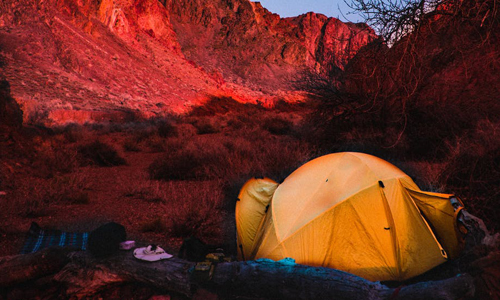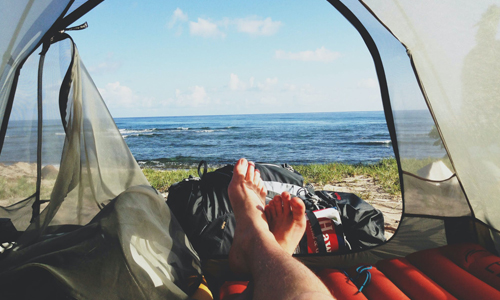Some Unsaid Rules of Wild Camping You Must Know
If we were to ask you what is the best part of going on an adventure what would it be? We are sure there would be many answers but dealing with unpredictable situations and discovering where each path will lead you will sure to be among them. Many of you must have seen those tranquil pictures wild camping and might even want to plan a trip for yourself.
Behind every successful wild camping, some unwritten and legal rules need to be addressed. You cannot just get your backpack, tie the shoelaces and leave for the adventure. You need proper planning and must following the rules that we are going to discuss below.
Learn the Basic Etiquette of Wild Camping
- Don’t Just Hang Around: The first rule to wild camping is to arrive late and leave early. This is how you can avoid others and can get fully packed before you encounter them.
- Open Fire is a Big NO: Remember to never light an open fire when wild camping. This can increase the chances of out of control fires and should not be practised at any cost.
- Follow Leave-No-Trace Rule: During and after your fun times, ensure that you don’t leave anything behind- especially waste. This will help protect the clean and fresh environment.
- The Right Toilet is a Must: You cannot decide the exact time for relieving. The basic rule of the correct toileting is to keep a distance of 50m away from the water bodies, dig a 6-inch deep hole, and cover the area properly. Take the toilet roll or wipes with you and do not dispose of them there.
- Wildlife Should be Respected: You should never disturb the wildlife. It is not only advisable for the protection of the environment but will also keep you safe. Never feed the animals or leave any food item for them either.
Look for the Right Camping Spot
Choosing or picking the right spot is important when planning a wild camp. You will see different signs on the map that will help you choose which spot is the best for you.
- Green slashes indicate a wet muddy ground, which means you’re likely to see midges at the spot. If you need to move to this spot, make sure you’re carrying insect repellents or a net.
- Blue lines mean that there are rivers. If it’s a larger li
 ne, there’s a lake. Camping near such areas is a great choice because that eliminates the need to carry water for cooking, drinking, and other activities. Just remember that you should always boil the water first.
ne, there’s a lake. Camping near such areas is a great choice because that eliminates the need to carry water for cooking, drinking, and other activities. Just remember that you should always boil the water first. - Broken lines are the symbol of paths and tracks. Such places are not recommended to the wild campers, so avoid looking for those broken lines.
- Wobbly black clusters are the sign of crags or corries. If you can see a C-shape pattern over the map, go for these and you’ll stay protected from high wind.
Apart from these helpful rules, packing the right type of essentials and equipment are also crucial. Ensure you’re carrying things for safety and comfort such as a quality sleeping bag, tent, camp stove, headlight, multi-functional knife, water drinking tablets, water filters, and a first aid kit.
Stay safe and enjoy. Happy Wild Camping!
Categories
- Sport (28)
- Product Reviews (3)
- Team Outdoor Look (7)
- Mike Wild (2)
- Mike Payton (2)
- Suse Hammond-Pears (3)
- Snowboarding (12)
- Latest Offers (105)
- Shop Talk (1)
- Competitions (7)
- Walking (413)
- Lifestyle Fashion (8)
- Travel (86)
- Kit Guides (176)
- Workwear Clothing (6)
- Safety Workwear (4)
- Health/Fitness (289)
- Skiing (91)
- Great Outdoors (1316)
- Cycling (92)
- January 2025
- December 2024
- November 2024
- October 2024
- September 2024
- August 2024
- July 2024
- June 2024
- May 2024
- April 2024
- March 2024
- February 2024
- January 2024
- December 2023
- November 2023
- October 2023
- September 2023
- August 2023
- July 2023
- June 2023
- May 2023
- April 2023
- March 2023
- February 2023
- January 2023
- December 2022
- November 2022
- October 2022
- September 2022
- August 2022
- July 2022
- June 2022
- May 2022
- April 2022
- March 2022
- February 2022
- January 2022
- December 2021
- November 2021
- October 2021
- September 2021
- August 2021
- July 2021
- June 2021
- May 2021
- April 2021
- March 2021
- February 2021
- January 2021
- December 2020
- November 2020
- October 2020
- September 2020
- August 2020
- July 2020
- June 2020
- May 2020
- April 2020
- March 2020
- February 2020
- January 2020
- December 2019
- November 2019
- October 2019
- September 2019
- August 2019
- July 2019
- June 2019
- May 2019
- April 2019
- March 2019
- February 2019
- January 2019
- December 2018
- November 2018
- October 2018
- September 2018
- August 2018
- July 2018
- June 2018
- May 2018
- April 2018
- March 2018
- February 2018
- January 2018
- December 2017
- November 2017
- October 2017
- September 2017
- August 2017
- July 2017
- June 2017
- May 2017
- April 2017
- March 2017
- February 2017
- January 2017
- December 2016
- November 2016
- October 2016
- September 2016
- August 2016
- July 2016
- June 2016
- May 2016
- April 2016
- March 2016
- February 2016
- January 2016
- December 2015
- November 2015
- October 2015
- September 2015
- August 2015
- July 2015
- June 2015
- May 2015
- April 2015
- March 2015
- February 2015
- January 2015
- December 2014
- November 2014
- October 2014
- September 2014
- August 2014
- July 2014
- June 2014
- May 2014
- April 2014
- March 2014
- February 2014
- January 2014
- December 2013
- November 2013
- October 2013
- September 2013
- August 2013
- July 2013
- June 2013
- May 2013
- April 2013
- March 2013
- February 2013
- January 2013
- December 2012
- November 2012
- October 2012
- September 2012
- August 2012
- July 2012
- June 2012
- May 2012
- April 2012
- March 2012
- February 2012
- January 2012
- December 2011
- November 2011
- October 2011
- September 2011
- August 2011
- May 2010
- April 2010
- March 2010
- February 2010
- January 2010
- November 2009
- October 2009
- September 2009
Submit a Comment